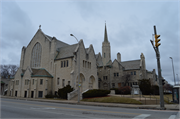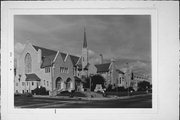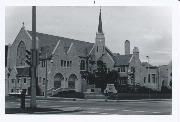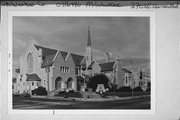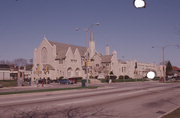Property Record
2703 N SHERMAN BLVD
Architecture and History Inventory
| Historic Name: | Sherman Park Lutheran Church |
|---|---|
| Other Name: | Sherman Park Lutheran Church |
| Contributing: | Yes |
| Reference Number: | 116940 |
| Location (Address): | 2703 N SHERMAN BLVD |
|---|---|
| County: | Milwaukee |
| City: | Milwaukee |
| Township/Village: | |
| Unincorporated Community: | |
| Town: | |
| Range: | |
| Direction: | |
| Section: | |
| Quarter Section: | |
| Quarter/Quarter Section: |
| Year Built: | 1928 |
|---|---|
| Additions: | 1960 |
| Survey Date: | 19792023 |
| Historic Use: | house of worship |
| Architectural Style: | Late Gothic Revival |
| Structural System: | |
| Wall Material: | Limestone |
| Architect: | Roy Oliver Papenthien; Herman H. Bruns |
| Other Buildings On Site: | |
| Demolished?: | No |
| Demolished Date: |
| National/State Register Listing Name: | North Sherman Boulevard Historic District |
|---|---|
| National Register Listing Date: | 4/6/2004 |
| State Register Listing Date: | 10/17/2003 |
| National Register Multiple Property Name: |
| Additional Information: | "2023- resurveyed as part of Milwaukee Houses of Worship thematic survey. ARCHITECTURAL SIGNIFICANCE: Example of late Gothic Revival church with limestone veneer. See Sherman Park West District form. Construction date, 1925-28. (1, 2) Lutheran Church, Owner, 1925-present. (1) ""Sherman Park Evangelical Lutheran Church is the result of a merger of Hope Lutheran Church (Missouri Synod) and Mount Lebanon Lutheran church (Wisconsin Synod). The merger was effected in a series of meetings in 1923 and the congregation was charted by the Missourit Synod as Sherman Park Evangelical Lutheran church in 1924. Hope Church had been organized in 1907 as a mission church of the German Wisconsin District. The church later joined English District of the Missouri Synod and purchased a site for a new church building at 48th and Elm Streets in 1915. Mt. Lebanon Lutheran Church was organized as part of the Wisconsin Synod in 1917. A portable chapel on 39th Street, north of Center, was the church's first home. The congregation purchased three lots on the northwest corner of Sherman Boulevard and Center as it grew along with the City of Milwaukee, which was expanding into adjoining farmland. Following the merger of Hope and Mt. Lebanon, a new church (called ""the bungalow church"") was built in 1926. it quickly became necessary to build a larger church and the present building, designed by the architectural firm of Velguth & Papenthien, was dedicated in 1929. During construction services were held at the Venetian Theater on Center Street. Sherman Park Lutheran has maintained a strong outreach to the community. The primarily German population built an educational wing, which was dedicated in 1969. The gymnasium provided opportunities for basketball, volleyball, and rollerskating. It is one of the very few fully-equipped church roller skating rinks in the country! The church also operates a pre-school and other congregations and organizations use the church."" (Spaces and Traces tour)" |
|---|---|
| Bibliographic References: | 1. Building Permit 2. Cornerstone of Building See HOW Site File. sherman park evangelical lutheran Spaces & Traces Home Tour: Grant & Sherman Boulevards, Diversity in Design, Historic Milwaukee Incorporated, May 8, 2004. |
| Wisconsin Architecture and History Inventory, State Historic Preservation Office, Wisconsin Historical Society, Madison, Wisconsin |

